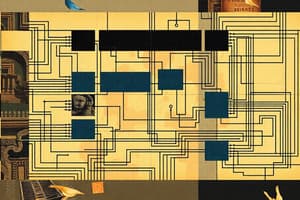Podcast
Questions and Answers
What is the primary function of a decoder in digital logic circuits?
What is the primary function of a decoder in digital logic circuits?
- To convert binary inputs to corresponding outputs (correct)
- To amplify input signals
- To perform arithmetic operations
- To store binary data
How many outputs does a decoder with N input lines generally have?
How many outputs does a decoder with N input lines generally have?
- N+1 outputs
- N outputs
- $2^N$ outputs (correct)
- $N^2$ outputs
Which logic gate can be used as the basic decoding element in a decoder?
Which logic gate can be used as the basic decoding element in a decoder?
- OR gate
- NAND gate
- AND gate (correct)
- XOR gate
What type of output does the 74138 active-LOW decoder produce for the decoded number?
What type of output does the 74138 active-LOW decoder produce for the decoded number?
For an active-HIGH output decoder like the 74139, what components are used for construction?
For an active-HIGH output decoder like the 74139, what components are used for construction?
When implementing a decoder with an active-LOW output, which logic gates can be utilized?
When implementing a decoder with an active-LOW output, which logic gates can be utilized?
What is the significance of zero suppression techniques in combinational logic circuits?
What is the significance of zero suppression techniques in combinational logic circuits?
In a 2-to-4-line decoder, what is the role of the enable input?
In a 2-to-4-line decoder, what is the role of the enable input?
What is the primary purpose of a full adder in combinational logic circuits?
What is the primary purpose of a full adder in combinational logic circuits?
Which components form the output S in the full adder implementation using a decoder?
Which components form the output S in the full adder implementation using a decoder?
How does an encoder function in comparison to a decoder?
How does an encoder function in comparison to a decoder?
What is the basic function of a 3-to-8 line decoder in a full adder circuit?
What is the basic function of a 3-to-8 line decoder in a full adder circuit?
In which scenario would you apply zero suppression techniques?
In which scenario would you apply zero suppression techniques?
Which of these outputs indicates a HIGH level from a decoder?
Which of these outputs indicates a HIGH level from a decoder?
What is the correct sum of min-terms expression for output C in a full adder?
What is the correct sum of min-terms expression for output C in a full adder?
What does the operation of a 7-segment display typically involve?
What does the operation of a 7-segment display typically involve?
What is the primary purpose of the Lamp Test (LT) feature in a 7-segment display?
What is the primary purpose of the Lamp Test (LT) feature in a 7-segment display?
Which of the following is a characteristic of leading zero suppression?
Which of the following is a characteristic of leading zero suppression?
In a common-cathode 7-segment display, where are the cathodes of the LEDs connected?
In a common-cathode 7-segment display, where are the cathodes of the LEDs connected?
What function does the BCD-to-7-segment decoder primarily serve?
What function does the BCD-to-7-segment decoder primarily serve?
What is the effect of trailing zero suppression in a number like 030.080?
What is the effect of trailing zero suppression in a number like 030.080?
What distinguishes a common-anode configuration from a common-cathode configuration in LED displays?
What distinguishes a common-anode configuration from a common-cathode configuration in LED displays?
Which of the following best describes how to implement a combinational logic circuit using a decoder?
Which of the following best describes how to implement a combinational logic circuit using a decoder?
What does zero suppression help achieve in multi-digit display systems?
What does zero suppression help achieve in multi-digit display systems?
Flashcards
7-segment display types
7-segment display types
Two types exist: common-anode and common-cathode.
Common Anode
Common Anode
All anodes tied to positive voltage (Vcc).
Common Cathode
Common Cathode
All cathodes tied to ground.
Lamp Test (LT)
Lamp Test (LT)
Signup and view all the flashcards
Zero Suppression
Zero Suppression
Signup and view all the flashcards
Leading Zero Suppression
Leading Zero Suppression
Signup and view all the flashcards
Trailing Zero Suppression
Trailing Zero Suppression
Signup and view all the flashcards
Decoder Implementation
Decoder Implementation
Signup and view all the flashcards
Full Adder Truth Table
Full Adder Truth Table
Signup and view all the flashcards
Sum of Min-terms
Sum of Min-terms
Signup and view all the flashcards
3-to-8 Line Decoder
3-to-8 Line Decoder
Signup and view all the flashcards
Encoder
Encoder
Signup and view all the flashcards
Input Code
Input Code
Signup and view all the flashcards
Min-term
Min-term
Signup and view all the flashcards
Boolean Functions
Boolean Functions
Signup and view all the flashcards
Combinational Logic Circuit
Combinational Logic Circuit
Signup and view all the flashcards
Decoder Function
Decoder Function
Signup and view all the flashcards
Active-HIGH Output
Active-HIGH Output
Signup and view all the flashcards
Active-LOW Output
Active-LOW Output
Signup and view all the flashcards
Decoder Enable Input
Decoder Enable Input
Signup and view all the flashcards
General Decoder Diagram
General Decoder Diagram
Signup and view all the flashcards
Study Notes
Multiplexers
- Multiplexers (MUX) are devices that take data from multiple sources and transmit it over a single line to a single destination.
- They consist of several data inputs (channels), a number of select lines to choose which input to transmit, and a single output channel.
- Input channels can have a single bit or multiple bits, determining the channel width.
- Different multiplexers have different numbers of input channels, which is often denoted as (n-channel x m-bit multiplexer).
- Boolean expressions can be used to describe the output based on the input and selection lines.
- Multiplexers have applications in displaying data, generating logic functions, and parallel-to-serial conversion.
- Some multiplexers feature active low or high outputs, and an enable input for controlling the device.
Problems and Solutions
- Analyze the provided diagrams and figures of multiplexers to understand their channel input/output configurations.
- Evaluate and name multiplexers in diagrams or illustrations to determine their channel/bit characteristics (e.g., "4 Channel x 1-Bit Multiplexer").
- Identify Boolean expressions of multiplexers given the inputs, select lines, and output to solve for logic equations.
- Identify output functions for provided mux diagrams and use this in conjunction with input data to define logic expressions.
Active Low or Active High Outputs
- Some commercial multiplexers have active-low or active-high outputs controlling the device.
- Some devices feature both output types.
Enable Input
- Some multiplexers include enable inputs that regulate overall device activity.
- An active high enable typically means the device only operates when the enable input is high.
Applications
- Multiplexing of Displays (Using a single seven-segment decoder driver to serve several displays)
- Logic Function Generation (Implementing logic operations using multiplexer)
- Parallel to Serial Conversion
The Light Emitting Diode (LED)
- The LED has an anode and a cathode.
- Current flow is from anode to cathode.
- Different LED colors have different typical forward voltages.
Common Anode 7-Segment LED Display
- The common anode configuration has anodes connected together.
- Common cathode configurations have cathodes connected together.
Logic Function Generation
- Multiplexers can implement logic functions with boolean expressions and input/select line combinations.
Implementation
- Provide a Boolean function using an '8-channel x 1-bit multiplexer', and identify the rows in the truth table where the function Z is true.
- Utilize input/select line and output combinations for different functions by an 8-channel x 1-bit multiplexer to build and analyze logic expressions.
Multiplexer Circuitry
- Detailed circuit diagrams of multiplexers often display input channels with different characteristics, showing how logic gates connect and are sequenced for specific outputs.
- Diagrams of various multiplexers showing input/output signals and corresponding truth table configurations illustrate the operational processes of different muxes with their configurations.
Commercial Multiplexers
- Commercial multiplexers (e.g., 54150/DM54150/DM74150, 54151A/DM54151A/DM74151A) are data selectors or multiplexers that perform specific tasks like parallel-to-serial conversion, multiplexing and generating boolean equations.
- Features like data line selections, propagation delays, and power dissipation are important specifications of commercial multiplexers.
- Logic diagrams demonstrate functionality, including data inputs, strobe inputs ("enable"), output sections, and select input connections.
Decoders
- Decoders are logic circuits that activate only one output corresponding to a specific input binary code while the others remain inactive.
- A decoder takes n inputs and produces 2ⁿ outputs with only one output high for a valid input.
- Decoders may be active-high or active-low, denoting when a specific output is activated (high or low, respectively).
- Decoders have applications in logic functions, timing and sequencing, and device control in various systems
Encoders
- Encoders convert a number of inputs to a coded output.
- They perform a "reverse" of decoding tasks.
- Encoders are utilized in many applications such as translating user inputs into coded instructions, and more.
- Priority encoders select the highest-priority input when multiple inputs are active simultaneously.
BCD-to-Decimal Decoders
- These decoders convert BCD code(binary coded decimal) to decimal values.
- These decoders employ NAND gates to ensure low active output.
- Implementation procedures for BCD to decimal decoders frequently use NAND based configurations and provide active low outputs for specific digits.
7-Segment Decoders/Drivers
- These decoders manage LED displays by activating specific segments based on BCD inputs.
- Functionality is more complicated, as multiple input combinations potentially activate the same segment(s).
- The logic complexity and specifications associated with segment decoders frequently rely on active high or active low logic.
- The figures (diagrams) show how different digit displays are generated with 7-segments LED's (Light Emitting Diodes).
HDL
- HDL is a Hardware Description Language used to design and implement digital systems.
- VHDL is one popular form of HDL to specify circuits.
- VHDL contains rules for designing with modules, using variables and constants, operations, and data types.
- HDL offers a procedural language which is used to describe the components in sequential and behavioral manners.
- HDL's allow design entities to be independently checked and tested using simulations which will display the data flow to show behaviour.
Studying That Suits You
Use AI to generate personalized quizzes and flashcards to suit your learning preferences.




